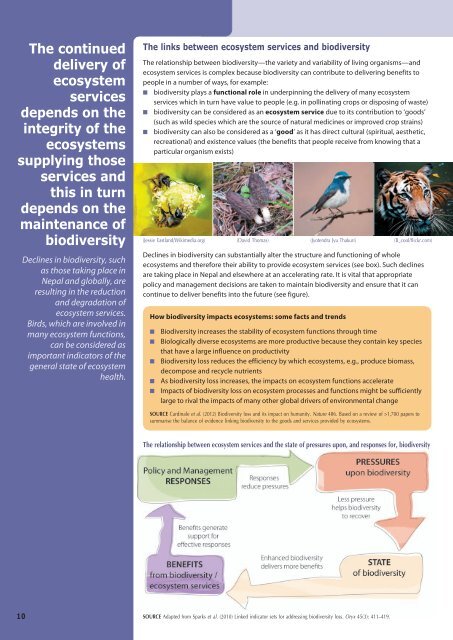CONSERVING BIODIVERSITY & DELIVERING ECOSYSTEM SERVICES
conserving biodiversity & delivering ecosystem services
conserving biodiversity & delivering ecosystem services
You also want an ePaper? Increase the reach of your titles
YUMPU automatically turns print PDFs into web optimized ePapers that Google loves.
Declines in biodiversity, such<br />
as those taking place in<br />
Nepal and globally, are<br />
resulting in the reduction<br />
and degradation of<br />
ecosystem services.<br />
Birds, which are involved in<br />
many ecosystem functions,<br />
can be considered as<br />
important indicators of the<br />
general state of ecosystem<br />
health.<br />
<br />
The relationship between biodiversity—the variety and variability of living organisms—and<br />
ecosystem services is complex because biodiversity can contribute to delivering benefits to<br />
people in a number of ways, for example:<br />
■ biodiversity plays a functional role in underpinning the delivery of many ecosystem<br />
services which in turn have value to people (e.g. in pollinating crops or disposing of waste)<br />
■ biodiversity can be considered as an ecosystem service due to its contribution to ‘goods’<br />
(such as wild species which are the source of natural medicines or improved crop strains)<br />
■ biodiversity can also be considered as a ‘good’ as it has direct cultural (spiritual, aesthetic,<br />
recreational) and existence values (the benefits that people receive from knowing that a<br />
particular organism exists)<br />
(Jessie Eastland/Wikimedia.org) (David Thomas) (Jyotendra Jyu Thakuri)<br />
(B_cool/flickr.com)<br />
Declines in biodiversity can substantially alter the structure and functioning of whole<br />
ecosystems and therefore their ability to provide ecosystem services (see box). Such declines<br />
are taking place in Nepal and elsewhere at an accelerating rate. It is vital that appropriate<br />
policy and management decisions are taken to maintain biodiversity and ensure that it can<br />
continue to deliver benefits into the future (see figure).<br />
How biodiversity impacts ecosystems: some facts and trends<br />
■ Biodiversity increases the stability of ecosystem functions through time<br />
■ Biologically diverse ecosystems are more productive because they contain key species<br />
that have a large influence on productivity<br />
■ Biodiversity loss reduces the efficiency by which ecosystems, e.g., produce biomass,<br />
decompose and recycle nutrients<br />
■ As biodiversity loss increases, the impacts on ecosystem functions accelerate<br />
■ Impacts of biodiversity loss on ecosystem processes and functions might be sufficiently<br />
large to rival the impacts of many other global drivers of environmental change<br />
SOURCE Cardinale et al. (2012) Biodiversity loss and its impact on humanity. Nature 486. Based on a review of >1,700 papers to<br />
summarise the balance of evidence linking biodiversity to the goods and services provided by ecosystems.<br />
The relationship between ecosystem services and the state of pressures upon, and responses for, biodiversity<br />
SOURCE Adapted from Sparks et al. (2010) Linked indicator sets for addressing biodiversity loss. Oryx 45(3): 411–419.




